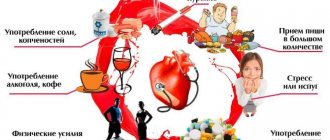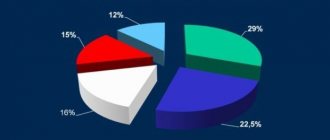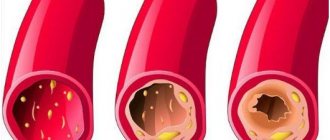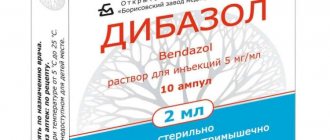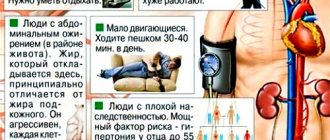Symptoms of high blood pressure
First you need to figure out which indicators are outside the norm. Pressure can be measured with a tonometer. This device produces two digits. The first is systolic pressure (the force of contraction of the heart), the second is diastolic (vascular tone when the heart muscle relaxes). Normal values for an adult range from 120/80 to 130/85. After the age of forty, the numbers 145/90 become the limit.
In addition to high tonometer readings, the following symptoms of high blood pressure are distinguished:
- irritability, anxiety;
- rapid heartbeat;
- feeling tired;
- headache;
- swelling;
- pulsation in temples;
- chills followed by hot flashes;
- goose pimples;
- poor sleep;
- dizziness.
There are a huge number of reasons for high blood pressure, from emotional stress to physical stress. If the jump occurs suddenly, then a dangerous hypertensive crisis begins. To be able to prevent irreversible consequences, you need to remember what symptoms are characteristic of this condition:
- facial redness;
- nervous overexcitation;
- pain in the heart area;
- goose pimples;
- trembling in hands;
- feeling of lack of air;
- visual impairment.
Injections for high blood pressure
Injections help bring the patient out of a state of hypertensive crisis. They can be performed intramuscularly, intravenously - injections or drips. The drugs differ in their action:
- diuretics remove excess fluid in the urine and have a long-lasting effect - Furosemide;
- ACE inhibitors block the factor responsible for increasing blood pressure, regulate water metabolism, act smoothly - Enap;
- peripheral vasodilators relieve tension in the smooth muscles of blood vessels, are not contraindicated during pregnancy - Magnesia and Dibazol.
When providing care in a hospital, injections are used for high blood pressure, which require monitoring by the doctor of the patient’s condition and the degree of decrease in blood pressure. If side effects occur, treatment is adjusted. This helps to achieve a comfortable state for the patient. In intensive care clinics, the following drugs can be treated:
- Nitroglycerin – relaxes the walls of blood vessels;
- Nifedipine – smoothly reduces indicators to normal;
- Eufillin – restores the functioning of the respiratory system;
- Relanium – relieves muscle spasms.
At what pressure should you call an ambulance?
This question is individual for each person. It is generally accepted that you should call an ambulance if the tonometer reading is 160/95, but there are many deviations from this rule. For hypotensive patients, for example, even numbers 130/85 are considered critical. The decision about whether to contact specialists is made depending on additional factors.
An ambulance with high blood pressure must come and provide services in the following cases:
- The person had an attack for the first time in his life.
- The first and repeated doses of drugs to reduce high blood pressure, used by hypertensive patients before, did not give any result after an hour.
- There was pain behind the sternum.
- Signs of a hypertensive crisis are noticeable.
Inpatient therapy
During a complicated crisis, blood flow to the brain is disrupted, which negatively affects cardiac activity. In the chronic course of such diseases, the patient may experience a stroke or heart attack. This increases the likelihood of death.
If the value approaches 220/120 mmHg, then internal organs may be damaged. After emergency care is provided to the patient, he is sent to the hospital. In its conditions, doctors normalize the indicators using the following injections:
- Clonidine - helps reduce blood pressure by 20% in 2 hours. Over the next 6 hours, the pressure normalizes to the operating limit. The patient feels well.
- Eufilin - restores normal breathing.
- Lasix + Captopril - a complex one-time injection or separate use of these injections every 30 minutes. The dosage is determined based on the patient’s reaction, since the medication can cause nausea and vomiting.
- Relanium - helps relieve muscle spasms. If the patient has been administered triplet, then the dosage of Relanium is reduced.
- Sodium Nitroprusside is administered by drip if high blood pressure is accompanied by clinical signs of heart failure.
A hypertensive crisis can lead to swelling of the brain and lungs. Therefore, the patient is discharged after stable treatment results. According to statistics, 40% of patients are readmitted to the hospital within the first 3 months after hospital treatment.
Pros and cons of injection therapy
The following features characterize the main injections for high blood pressure:
- Furosemide is administered slowly but can cause serious side effects including nephritis.
- Enap - injected slowly. Sometimes it provokes migraines, dry coughs, and allergies.
- Magnesium sulfate - promotes thickening of the airways, can cause apnea.
- Dibazol - used over a long course.
The advantages of the drugs include a drop in pressure within 30 minutes after the injection. All of the above products are characterized by high efficiency. The disadvantages of the injections under consideration include:
- high percentage of adverse reactions;
- against the background of long-term therapy, problems with the liver and kidneys appear;
- a sharp decrease in pressure leads to collapse and shock;
- The method of administration is considered traumatic, and infection may occur.
What to do with high blood pressure
It is imperative to force the patient to lie down and provide a calm environment. It is impossible to do any work, be it physical or mental, with high blood pressure. Ventilate the room in which the patient is located, dim the lights in it, and maintain silence. There should be no strong odors in the room. If the person has had seizures before, give them the medications they usually take. If your condition worsens or there is no positive dynamics for more than an hour, call a doctor.
Heart tablets under the tongue
To treat an attack of angina, it is recommended to place a Nitroglycerin tablet under the tongue. This is due to the fact that the oral cavity, and especially the sublingual space, has a well-developed circulatory network and the absence of the destructive influence of hydrochloric acid, enzymes of gastric and intestinal juice. The active substance easily penetrates the mucous membrane and does not require passage through the liver.
Sublingual administration helps to significantly speed up the onset of the drug’s work, and in terms of the rate of entry into the blood, this method is comparable to intravenous administration, but can be used by the patient for self-help at home.
Sublingual forms are developed for many groups of medications - sedatives, antihypertensives, enzymes, antiallergic drugs, potency enhancing drugs. The issue of speed of action is especially relevant for cardiac drugs, since a prolonged attack of angina pectoris turns into myocardial infarction.
Reduce blood pressure quickly at home
There are many options:
- It is recommended to quickly take special medications to lower blood pressure at home.
- You can try traditional methods that help bring high blood pressure into order.
- Effects on certain acupuncture points and some massage techniques are very effective.
- Breathing exercises help relieve symptoms.
Groups of drugs for injection
Injections for high blood pressure in medicine are divided into 3 main types:
- Diuretics. Used to quickly remove fluid from the body, as well as reduce blood volume. Due to this, a decrease in pressure indicators appears. Long-acting medications are good for almost any hypertensive patient.
- ACE inhibitors. Such drugs can block the negative effects of hormones and other factors that increase blood pressure. The decrease in pressure is gradual, it is prescribed very often during inpatient treatment, injections are suitable for elderly patients.
- Peripheral vasodilators. The injections reduce vascular tone and have a hypotensive effect. The drug is administered intravenously and can be used even during pregnancy.
To bring the pressure levels back to normal and the result to be stable, there will only be a few injections. A sick person definitely needs to change his diet, lifestyle, and also adjust his reactions to stressful situations. Strengthening the muscles of the heart and vascular system will be no less useful. Proper treatment eliminates the occurrence of crises and has a positive effect on the patient’s quality of life. If the rate is high, it is 200 per 100 mm Hg. Art., then medical assistance must be provided immediately.
After the crisis has been relieved, the patient must undergo a diagnostic test of the body, which allows one to understand the nature of the surges and determine the causes. This makes it possible to choose the type of treatment. Otherwise, the crisis may recur, complications appear in the form of stroke, heart attack and other irreversible consequences leading to disability and death.
First aid tablets for high blood pressure
The list of drugs with this function is very extensive. According to the mechanism of action on the body, there are several groups of emergency tablets for high blood pressure:
- Diuretics . Diuretic drugs that remove excess fluid from the body in which salts are dissolved: Indapamide, Furosemide.
- Beta blockers . Medicines that stabilize the heart: Atenol, Leveton, Bisoprolol.
- Receptor blockers . Fast-acting drugs: Eprosartan, Losartan, Valsartan.
- Calcium channel blockers . Prevent calcium from penetrating into the tissues of the heart and blood vessels: Norvasc, Nifedipine, Amlodipine, Cardizem, Adalat.
- ACE inhibitors . The most effective and well-known remedies for high blood pressure, providing quick and long-lasting results: Berlipril, Captopril, Altan.
Mexidol for hypertension
The main active ingredient of the drug is ethylmethylhydroxypyridine succinate. The main function of Mexidol for hypertension is to make organs and tissues more resistant to oxygen starvation by preventing the harmful effects of free radicals. The medicine has a large list of indications. The tablets may cause minor gastrointestinal upset.
Mexidol is taken according to the following scheme:
- Twice or three times, 3-6 tablets per day.
- An easy course of treatment is 14 days, in difficult cases up to one and a half months.
- You should start and stop taking it gradually. First, over three days, the dosage is gradually increased from one or two tablets to the one recommended by the doctor, then it is also reduced until completely discontinued.
Nitroglycerin for high blood pressure
The drug acts instantly and is eliminated from the body in the shortest possible time. Nitroglycerin relieves heart pain in high blood pressure. The medicine is very often taken for angina pectoris. It can also be used for prophylaxis before physical activity, so that there is no increase in blood pressure as a result. Be sure to drink it as written in the instructions.
The whole tablet or a ladle should be placed under the tongue, and be sure to take a sitting or lying position. If there is no effect, the medicine is re-taken after 5 and 10 minutes, after which an ambulance is called. It is best to start systematically with half a tablet to avoid addiction. The regimen of use should be prescribed by a doctor after a detailed examination of the patient.
It’s sad that with all the advantages of Nitroglycerin, it has a lot of side effects and contraindications. People with individual intolerance to the drug may experience a sharp increase in heart rate, pain, dizziness, and near fainting. Nitroglycerin should not be taken if you have high intracranial pressure, glaucoma, heart attack and stroke, or kidney failure.
Anti-pressure tablet under the tongue
Such drugs are very popular because they act as quickly as possible. The pressure tablet should be dissolved under the tongue. Its components immediately enter the bloodstream and reach the heart muscle, bypassing the digestive organs. In this case, the substances do not come into contact with stomach acid, which negatively affects them. There are many medications taken under the tongue. It is worth describing the most popular ones.
Corinfar under the tongue
The active ingredient of the tablets is nifedipine (10 mg). Corinfar under the tongue quickly lowers high blood pressure, minimizes the load on the heart, and expands the lumen of blood vessels. The drug is used both occasionally for hypertensive crises and for regular treatment. It is indicated for those who suffer from arterial hypertension and angina pectoris. During a crisis, 1-2 tablets should be dissolved, kept under the tongue. The drug acts after 20 minutes, the effect lasts for 4-6 hours.
The medicine has a number of side effects, so you should take it only if prescribed by a doctor. Taking the pill can cause:
- bradycardia;
- swelling of the legs;
- headache;
- weakness.
It is strictly forbidden to take Corinfar when:
- hypotension;
- lactation period;
- chronic heart failure;
- first trimester of pregnancy.
Physiotens under the tongue
The main active ingredient in this medicine is moxonidine. Tablets with 0.2 mg of the component are pale pink, with 0.3 mg - coral, with 0.4 mg - deep red. Physiotens under the tongue lowers high blood pressure by acting on certain receptors. The medicine works very quickly. If emergency assistance is required for a hypertensive crisis, one or two tablets with a dosage of 0.2 mg should be placed under the tongue. The daily dose should not exceed 0.6 mg. The drug has a number of side effects, but they appear only at the initial stage of administration and then disappear.
What to inject for blood pressure?
Often, with a sudden and sharp increase in blood pressure, a person who has not previously encountered such a problem is lost and does not know what to inject for blood pressure. And even if a person knows such a “sin” behind him, sometimes he wonders what to do. In any case, you need to consult a doctor, since it is not always possible to cope on your own. However, the first aid kit for such situations should contain the necessary drugs.
What is usually taken for high blood pressure?
Usually, for high blood pressure, a tablet under the tongue is sufficient - for example, Nifediline, Corinfar or Kaptopress. The effect of application is achieved very quickly - after 15-20 minutes and lasts for 4-6 hours.
In other cases, it is possible to use a higher dose of the usual routine medications, if they are taken at all. As a rule, a single dose of the drug is enough, and the pressure returns to normal. But if, even after repeated use, high blood pressure persists, a headache also appears. chest pain, nausea, shortness of breath, vomiting, lightheadedness (and sometimes loss of consciousness) occur, then you need to call an ambulance - most likely, a hypertensive crisis begins.
Emergency help at home
What if it is not possible to call an ambulance for some reason? If someone close to you knows the intramuscular injection technique, then you can use the most effective and safe method of lowering blood pressure. which is usually used in hospital settings is an intramuscular injection of dibazole with papaverine. Although emergency doctors usually prefer to inject magnesium sulfate 10 ml due to its rapid action.
Actions of the Emergency Doctor
An emergency physician may administer the following drugs intravenously:
- Enalaprilat . 1 ampoule contains 1.25 mg of active substance, effectively reduces blood pressure;
- Clonidine 0.01 % 1 ampoule contains 1 ml of active substance. Reduces heart rate and blood pressure;
- Furosemide 1%. 1 ampoule contains 1 mo of active substance. It has a diuretic effect, due to which the volume of circulating blood decreases, which leads to a decrease in blood pressure;
- Magnesium sulfate, or magnesia 25%. 1 ampoule contains 10 ml of active substance. Magnesia produces diuretic and sedative effects, relieves vasospasm and thereby causes a decrease in blood pressure.
Treatment in hospital
In the hospital, treatment takes place according to a different scheme, with other drugs, the use of which requires constant medical supervision:
- Nitroglycerin 0.1% #8212; in an ampoule 10 ml. administration by drip or using a dispenser. Produces a powerful vasoconstrictor effect;
- Sodium nitroprusside . Ampoule contains 0.05 ml. Sharply reduces blood pressure;
- Metaprolol. Ampoule contains 5 ml. Reduces the intensity and frequency of heart contractions;
- Pentamin 1%. Ampoule contains 1 ml. Blocks the nodes of the sympathetic and parasympathetic nervous system, which leads to a decrease in blood pressure.
MOST INTERESTING NEWS
Dropper for high blood pressure
Intravenous administration of drugs is indicated for hypertensive crises. An IV for high blood pressure is usually given if the indicators are critical and there is a danger to life. Names of drugs that are administered:
- Dibazol . Prescribed as first aid for high blood pressure without complications. The drug relieves spasms, normalizes blood flow in the brain and heart. The hypotensive effect of the dropper lasts up to three hours, after which a general improvement in well-being occurs. Dibazol sometimes does not help older people.
- Magnesia . The drug is dripped once or twice a day, the total amount should not exceed 150 ml. Feeling better occurs half an hour after the start of the procedure. Only 25% magnesium solution is allowed to be used, no exceptions. The drug has many contraindications.
- Aminazine . The medicine is indicated for hypertensive patients who exhibit symptoms such as nervousness and anxiety. The drug sharply lowers high blood pressure, so it should be used with extreme caution. The indicators begin to fall immediately as soon as the IV is placed, and after a quarter of an hour they completely return to normal. The drug has a negative effect on the liver.
Video on the topic
What injections for high blood pressure are considered the most effective? Answer in video:
Despite the fact that injections for high blood pressure have a quick effect, they cannot become a permanent way to eliminate hypertension. Firstly, because their effect can be considered immediate, that is, injections reduce blood pressure, giving a temporary result, but do not in any way affect the treatment of the disease itself.
Secondly, the medications included in one or another type of injection for blood pressure have many side effects and should be selected with caution if the patient has other concomitant diseases.
Thirdly, injections to reduce blood pressure are one of the most painful methods, in which there is a risk of infection from the external environment and the likelihood of injury to the injection site. The only adequate way to maintain normal blood pressure levels should be complex therapy, subject to maintaining a correct lifestyle and adhering to a specially prescribed diet.
The information on the MyMedNews.ru website is for reference and general information, collected from publicly available sources and cannot serve as a basis for making a decision on the use of medications in the course of treatment.
MyMedNews.ru
And we also have
Ganaton or Itomed?
Injections for high blood pressure
Often, first aid for hypertension is provided by intramuscular and intravenous injections. Nobody gives injections for high blood pressure on their own. The procedure is carried out either in a hospital or by emergency doctors at home. The choice and dosage of the drug is made based on the patient’s symptoms. First aid for high blood pressure at home is done with the following medications:
- triad: Papaverine, Analgin, Diphenhydramine;
- Enalapril;
- Papaverine with Dibazol;
- Clonidine;
- Furosemide;
- Magnesium sulfate.
The following injections may be prescribed in the hospital:
- Nitroglycerine;
- Sodium nitroprusside;
- Metoprolol;
- Pentamin.
In case of hypertensive crisis, hot injections can be given:
- calcium chloride solution;
- Magnesia.
Classification of medications
To normalize blood pressure, one injection is not enough. It is recommended to change your lifestyle. Diet therapy is indicated. To lower the indicators, you will need to refrain from stress, strengthening the blood vessels and heart with folk remedies. Only complex and adequate therapy prevents a hypertensive crisis. If the pressure value is 200/100 mmHg, the patient requires urgent assistance.
Injectable medications for high blood pressure are divided into 3 categories:
- Diuretics - prescribed to remove excess fluid with urine. Against the background of a reduction in circulating blood, the pressure in the artery can be lowered. Diuretic therapy has a prolonged effect.
- ACE inhibitors - quickly block factors that increase blood pressure. With their introduction, the rates decrease slowly, but this treatment is suitable for many patients. Such injections are often prescribed to elderly patients.
- Peripheral vasodilators - reduce vascular muscle tone, producing a hypotensive effect. These injections are given to pregnant women.
In case of a one-time hypertensive crisis, it is recommended to visit a cardiologist. The doctor is developing a further treatment plan. If left untreated, the disease will cause serious complications. The result of the process under consideration is visual impairment, disability, and death.
List of universal means
For high blood pressure, a triad is taken - Diphenhydramine + Analgin + Papaverine. The ampoules of such injections contain the required dosage of medications. The above injections for high blood pressure are administered in combination or sequentially.
During a crisis, the triad has the following effects:
- Papaverine - this injection stops an attack by relaxing the artery and improving blood supply in peripheral tissues. At the same time, blood flow in the heart and kidneys does not change. Papaverine can be replaced with No-shpa with Drotaverine. The difference between No-shpa and Papaverine is that it relieves smooth muscle tone without affecting blood vessels. Papaverine relieves spasms, providing an analgesic effect
- Analgin is a fast-acting anesthetic that has restrictions on its use. Therefore, the triad is introduced once, but not constantly.
- Diphenhydramine - has a sedative effect. But during its administration, the patient may experience drowsiness.
The triplet cannot be placed independently. This injection cocktail does not treat hypertension. With its help, you can reduce blood pressure for a certain period.
Combination therapy
What injection will help normalize blood pressure in hypertension? The choice of drug depends on the general condition of the patient and the frequency of the crisis. If the indicator value is very high, then the combination Papaverine (2 ml) + Dibazol (4 ml) is administered. A timely injection prevents subsequent complications due to hypertension.
Before administering any injection, the doctor examines the conditions that may increase blood pressure. The above scheme is effective if the crisis is provoked by arterial spasm. In this case, the injection is administered slowly. At the same time, blood pressure is monitored. If the pathology is accompanied by severe pain in the temple, the Analgin + Dibazol + Papaverine regimen is used.
If you exceed their dosage, side effects may occur, including dizziness, migraine, nausea. Papazol is injected into the muscle only on the recommendation of a doctor. When determining the dosage of the injection, anamnesis, blood pressure readings, and the likelihood of side effects are taken into account. Dibazol is not administered to diabetics, hypotensive patients, or with frequent convulsions and bleeding in the gastrointestinal tract. Such effective injections for high blood pressure are not prescribed to people over 60 years of age. Not administered for vision loss or glaucoma.
Hot therapy
Such treatment is effective if blood pressure rises sharply, which can provoke a crisis. The hot injection should be administered gradually over 3-5 minutes. Hot remedies also include injections with magnesium or magnesium sulfate. But this solution is painful, so it is administered in combination with Novocaine. Doctors use a 25% solution to quickly restore blood pressure levels.
The advantages of such injections include:
- possibility of removing excess fluid;
- dilation of blood vessels.
But an overdose of magnesium disrupts the heart rhythm. There are certain rules for administering injections indicated to reduce blood pressure:
- using a syringe with a needle, the length of which is at least 4 cm, and it must be very thin;
- pre-warming the ampoule in your hands;
- smooth and slow introduction of the drug;
- injection area - the upper half of the buttock.
Magnesia is in great demand among doctors and patients. It quickly acts on blood pressure readings. Due to sudden and frequent changes in pressure, blood vessels and the heart wear out. If adequate treatment is not given, vision loss may occur. After 5-7 years the patient dies. In the hospital, a hot injection sometimes relieves the symptoms of a crisis. But modern medicine provides for the use of other methods of therapy.
Reduce blood pressure quickly using folk remedies
There are several effective ways. To reduce blood pressure using folk remedies, quickly take the following measures:
- Warm your feet in hot water for 10 minutes.
- Soak a cloth in vinegar (apple or table vinegar) and apply to your heels.
- Place mustard plasters on your calves and shoulders.
Herbs for blood pressure
Remember a few recipes:
- 1 tbsp. l. motherwort and hawthorn, meadowsweet and dried grass and 1 tsp. Mix valerian root and pour half a liter of vodka. Leave the anti-pressure herbs like this for 2 weeks. Drink 1 tbsp three times a day. l. (before meals).
- Make a strong mint infusion. Drink it, and also apply lotions to your neck, back of the head, and shoulders.
Advantages of injections over tablets
Injections for hypertension have a quick and pronounced therapeutic effect. However, they cannot be used frequently (like blood pressure pills). This is due to the fact that injections can provoke a number of adverse reactions.
It is also worth considering the fact that the lowering effect on blood pressure after injections does not last long, so it is better to consider them as emergency care (and only with the permission of a cardiologist).
What do you inject for high blood pressure (for example, first aid)? Most often, patients with hypertension are given intramuscular injections, and these are “Papaverine”, “Dibazol”, “Analgin” simultaneously or in turn.
This medicinal mixture quickly reduces blood pressure, eliminates cephalalgia, and normalizes the patient’s condition.
The proportion of these drugs is determined by the doctor individually, based on blood pressure, age category, and the presence of concomitant diseases.
These medications have contraindications and a number of adverse reactions, so they should be used with caution.
To normalize blood pressure and maintain it at the proper level, it is better to give preference to tablets, as they have a prolonged effect.
Medicines are selected individually, taking into account the characteristics of the patient’s body.
The most effective names of drugs for the heart
The popularity of Nitroglycerin for relieving an attack of angina is associated with its availability:
- low price category,
- produced by domestic manufacturers,
- Possibility of purchasing without a prescription,
- long experience of use.
Effect of Nitroglycerin for heart pain
In addition to regular tablets, you can use a spray under the tongue. The onset of action usually occurs within 5 minutes. After a few minutes, it is acceptable to reuse the sublingual tablet or spray. There are other effective means for relieving cardiac ischemic pain.
Watch the video about the correct use of Nitroglycerin:
Cardiket
It contains isosorbide dinitrate. This compound provides rapid elimination of pain, the effect appears in 50 - 60 seconds, and since Cardiket is a long-acting nitrate, the duration of pain relief lasts 2.5 hours. Used for angina pectoris in the following cases:
- relieving an attack
- prevention of myocardial ischemia before planned physical or emotional stress,
- in acute coronary insufficiency (under pressure control).
The initial dose is 5 - 10 mg for sublingual use
Use with caution in old age. Analogues of the active substance are: Nitrosorbide, Isoket, Isacardin
Corvaton
Does not apply to nitrates, but has a similar mechanism of action:
- vascular smooth muscles relax under the influence of nitric oxide;
- dilates veins more than arteries, reducing the load on the heart;
- improves blood fluidity;
- reduces the degree of myocardial hypertrophy;
- reduces pulmonary hypertension.
After sublingual administration, it begins to act within 7 - 10 minutes, and with normal ingestion - within 20 minutes. Unlike nitrates, there is no resistance to Corvaton, and it is less likely to cause headaches. The active ingredient is molsidomine. It is also known under the trade name Sydnopharm.
Nifedipine
Refers to calcium channel blockers. The mechanism of action for angina pectoris is to decrease the tone of peripheral vessels, dilate the coronary arteries and increase the resistance of the myocardium to hypoxia. It is more often used to relieve a hypertensive crisis, but Nifedipine tablets under the tongue can help patients with angina pectoris in the absence of Nitroglycerin.
The advantage of the drug is a slight decrease in the excitability and conductivity of the myocardium.
Simple short-acting forms of Nifedipine are suitable for sublingual use. One tablet contains 10 mg of active substance. The onset of the effect occurs within 7 - 10 minutes after administration. Analogs of the drug are: Corinfar, Adalat, Cordafen, Phenigidine.
The essence of the measures applied
The readings on the tonometer are above 139/90 mmHg. Art. signal the presence of problems in the body.
As a rule, high blood pressure indicates increased work of the cardiovascular system, which undergoes enormous stress. As a result, the heart muscle is forced to pump large volumes of blood through the narrowed vessels.
With a maximum increase in blood pressure, anyone can experience an unbearable headache. Taking appropriate painkillers will not give the expected effect. On the contrary, they can only hide the signs of a developing disease in the body. It is for this reason that this phenomenon requires immediate action.
The first and main condition for providing proper assistance in the event of a hypertensive crisis is consistency and literacy. You should not sharply reduce your blood pressure. This needs to be done gradually and smoothly. This is precisely the main point with high blood pressure.
It is very important that it does not drop faster than 28 or 25 mm in 60 minutes. An accelerated decline in indicators is not only impractical, but also dangerous.
It is very important to carefully monitor that the patient does not experience arrhythmia attacks . It is important to provide him with complete rest.
To eliminate mental agitation, special sedative medications are indicated.
The first step is to get rid of the factors that provoke increased blood pressure. There is no need to neglect the main point of treatment - providing a calm and comfortable environment for the patient. Usually, when the readings on the tonometer increase, a person begins to have panic attacks.
This state of the body has a tremendous impact on the activity of the sympathetic nervous system, which increases blood pressure even more. It is for this reason that before giving emergency medications against high blood pressure, the patient should be reassured.
Before the ambulance arrives, you need to do the following:
- place the patient's head on a high pillow;
- provide him with free access to fresh air;
- if necessary, place mustard plasters on the calf of the legs and the back of the head;
- if breathing is impaired, the person should take several inhalations and exhalations.
When taking emergency pills for high blood pressure, you need to change it regularly - at least once every half hour. If it gradually begins to decrease, but discomfort is noted in the chest area, it is important to call an ambulance in a timely manner, as these may be symptoms of a myocardial infarction.
It is not recommended to take emergency medications on your own to lower blood pressure, as this can be fraught with serious consequences.


